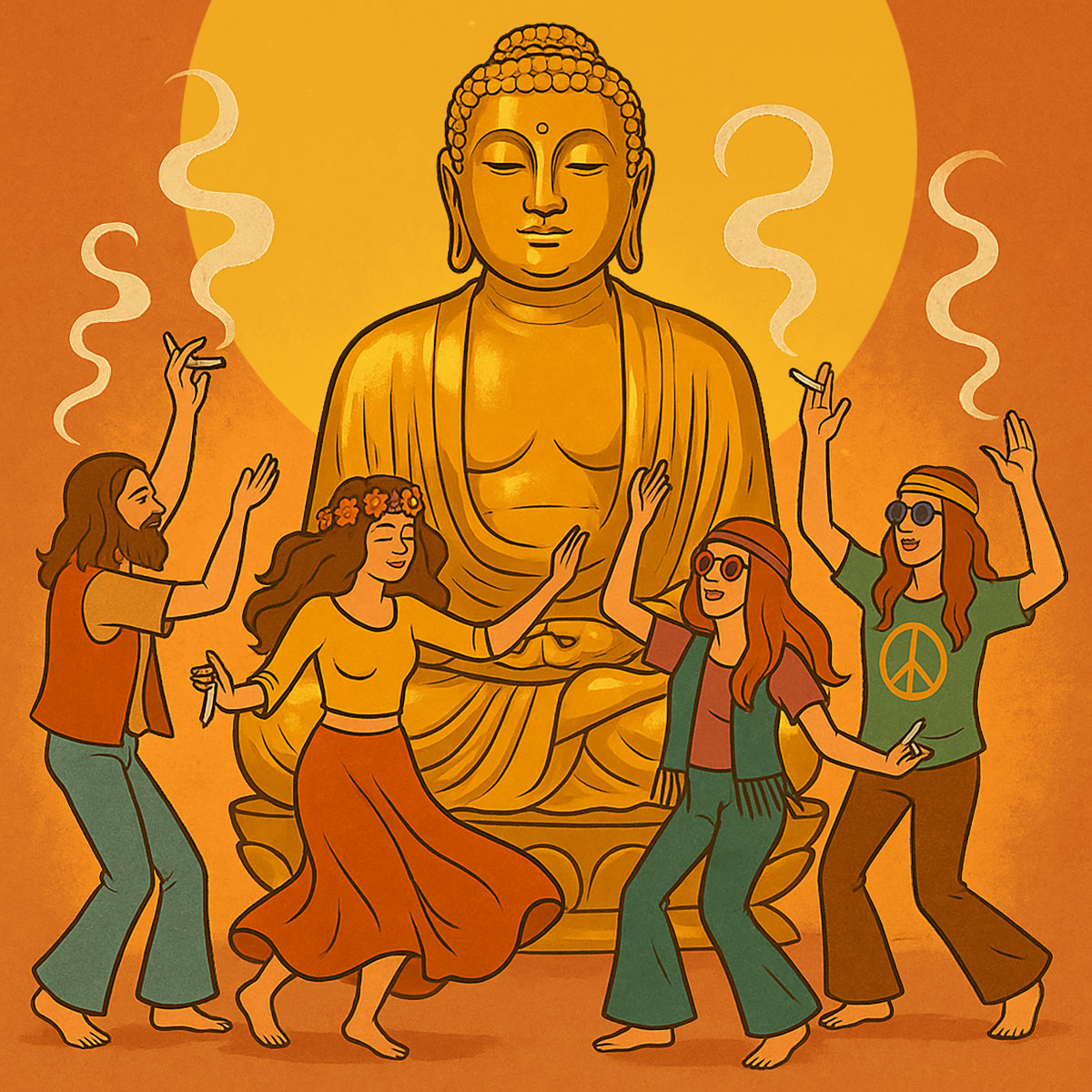Author: Dr. Kim, Medical Doctor at Aurea Care (Pen name)
Centuries before neuroscience, the Buddhists looked inward and saw what labs are only now confirming: the world you experience isn’t the world itself, but a mental construction. And the “you” doing the experiencing is no exception. You are nothing but an illusion the brain assembles on the fly. An improvised identity stitched from memory, mood, and sensation into the illusion of one continuous self. A useful fiction, mostly there so you don’t bolt upright every morning wondering who you are and what the hell is going on.
Centuries later, neuroscience has arrived at the same conclusion. But Buddhists didn’t need fMRIs. The cushion was their lab bench, the breath their instrument, and each emotion and thought a data point. They treated the mind itself as a laboratory, watching constructions rise and dissolve with the patience of monks and the rigor of scientists.
Today, we run the same experiment, just a little less gracefully. Swap the cushion for a couple hundred milligrams of THC and a cup of coffee we’ll set down in the bathroom, forget overnight, and rediscover stone-cold at 7 a.m.
Let’s dive in.
How Reality Gets Built
Here’s the thing about reality: you’ve never actually seen it. Ever. I know, that sounds like sci-fi nonsense, but hang on. Open your eyes and a world appears. Solid, obvious, undeniable. Trees, coffee cups, traffic lights. Looks real enough, right? Nope. That’s just your brain pulling a magic trick.
It’s not a camera recording the world. It’s a guess machine. Light hits your eyes, sound rattles your ears, and your brain shrugs and goes, “Uh, probably a tree. Or a cat. Let’s roll with that.” It builds a version of the world from scraps of data and a whole lot of educated guessing. Most of the time the
guess works fine—good enough to keep you from stepping in front of a bus or pouring milk on your laptop. But it’s still a hallucination. A really convincing one.
And here’s the kicker: it never stops. From your first breath to right now, your brain has been updating and refining its little fake-world project. You’ve been living in that simulation ever since. The only time the guessing shuts off is in dreamless sleep or under anesthesia—and even then, it’s just on pause. The moment you wake up, the projector whirs back to life and says, “Welcome back! Here’s reality, version 8,529,631. Please enjoy your stay.”
Now, here’s the slightly nerdier part.
Your brain’s sensory cortex is packed with tiny repeating circuits called cortical columns—T-columns if you want to sound impressive at parties. Each one does a tiny job: detect a line, a curve, a bit of motion. Think of them as Lego bricks. By themselves, they’re useless. But stack enough together and boom: you’ve got a coffee cup. Or your neighbor. Or a tree.
The brain’s done it a million times—it doesn’t need the full instruction manual anymore. Just a few hints, and it fills in the rest.
So when light hits your retina, you don’t see photons. You see green. Grass, a traffic light, maybe a leaf on the sidewalk. When sound hits your ear, you don’t hear pressure waves. You hear your friend’s voice. Or your dog barking. Or your neighbor yelling at their kids.
The point is, you never get the raw stuff—photons, vibrations, pressure. You get the brain’s version: colors, shapes, voices, objects.
Bottom line: reality is what your brain builds from its own preloaded kit. And you live inside that build.
Now, let’s dive deeper into T-columns (because they’re awesome).
Lego blocks for reality is a good analogy. But maybe a better one is language. As an adult, you’ve got a whole vocabulary rattling around in your head. You mix and match from that library to build sentences. And those sentences can be anything from total gibberish to something that wins a Pulitzer. Language lets us conjure infinite realities on the page: great stories, greater recipes, manifestos, love letters, tax-evasion schemes.
T-columns work the same way. Only instead of recipes and love letters, they write your lived reality. They build experience itself: what you see, what you hear, and how it feels to be you.
Pick an ordinary, well-rehearsed combination of T-columns and the brain gives you Tuesday. Pick another, and the world doesn’t settle into its usual shape. Suddenly you’re living inside a Tim Burton film or a Salvador Dalí painting.
In the end, the world you inhabit isn’t base reality. It’s the version your brain can construct. Which, most of the time, is enough to get you across a crosswalk alive.
And when the signals are incomplete—and they always are—memory jumps in to fill the gaps. It pulls from its library of past patterns and finishes the scene: We’ve seen this before. Probably a face. Or a cup of coffee.
Attention highlights the interesting bits. Emotion decides how much to freak out. The result feels like contact with the world. But it isn’t. You never meet base reality itself. You meet the version your nervous system assembles from its own templates.
Your lived reality isn’t a reflection of what’s “out there.” It’s whatever program happens to be running in your brain. The sensory input is only the keystrokes. The symphony—the world you actually live in—is composed behind your eyes.
Then You Add THC
When you add THC, the foreman of your brain’s reality-construction crew—the one who keeps the blueprints straight and the walls straight—steps out for a smoke break.
And just like that, the surrealists take over the job site. The Tim Burtons and Salvador Dalís of the crew dig into the Lego bin (T-columns) and start pulling out the stranger pieces—the curves that don’t quite connect, the shadows with no source, the memory fragments that feel like déjà vu.
They get to work building a world that’s almost normal… but not quite. Think enchanted forests. Staircases to nowhere. Fairy-tale logic.
The structure doesn’t collapse. It just changes style. Less IKEA catalog, more funhouse mirror.
The world becomes more surreal, more fluid—and sometimes, oddly captivating. It stops feeling like a machine and starts feeling like a painting. And when you’re inside it, you start noticing the brushstrokes.
With the foreman gone, the practical circuits start crashing.
You forget your PIN. You walk into the kitchen like a man on a mission—then stand there blinking at the sink like it’s going to remind you why you came. On the chessboard, you hang your queen in one move and immediately wonder how you ever got out of kindergarten.
In place of being a functioning adult, you gain a strange new superpower: seeing the really big and the really small.
One moment you’re zoomed out. You’re staring at the arc of human history and your place in it. You gaze at the stars and feel the depth of space. You see the universe’s 13.8-billion-year timeline—and your improbable cameo in it. Then you think about the college you didn’t choose. The job you shouldn’t have taken. The girl you should’ve called back. How none of it matters, yet somehow, it’s all that matters.
The next, you’re zoomed all the way in. You picture a protein folding like origami. Zoom in far enough—past cells and molecules, past atoms and electrons—and all that’s left is math. A kind of cosmic operating system that underpins everything.
Then you notice your handwriting.
You stare at it like it holds the key to who you are. Wait—has it always looked like that? When did I stop dotting my i’s like a teenager? Why does that feel important?
You shake your head. It’s just handwriting.
…Probably.
So here’s the neuroscience take: THC binds to CB1 receptors—especially in the prefrontal cortex, hippocampus, and amygdala. Translation: THC messes with the parts of your brain in charge of memory, emotion, and not making a complete fool of yourself in public.
The Buddhists would nod knowingly. Not at the receptor stuff—that’s not really their jam—but at what it leads to. They’ve been doing this without molecules for millennia. Sit still, follow the breath, and the mind quiets down.
Same result, different method.
The monk sits still and watches the mind build the world. The stoner lights up, watches it glitch, and goes: Wait… has this whole thing been built from Lego all along?
Sometimes what comes up is just weird. Sometimes it’s profound. And sometimes, when you light up or meditate, you catch a deeper glimpse of how the world works.

